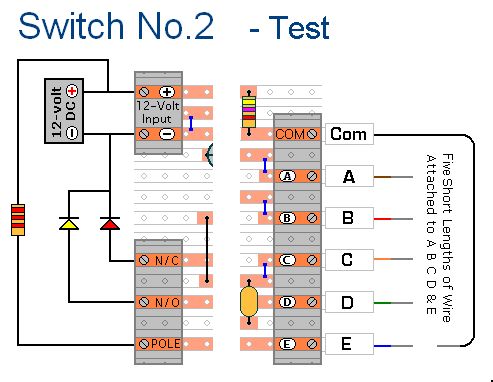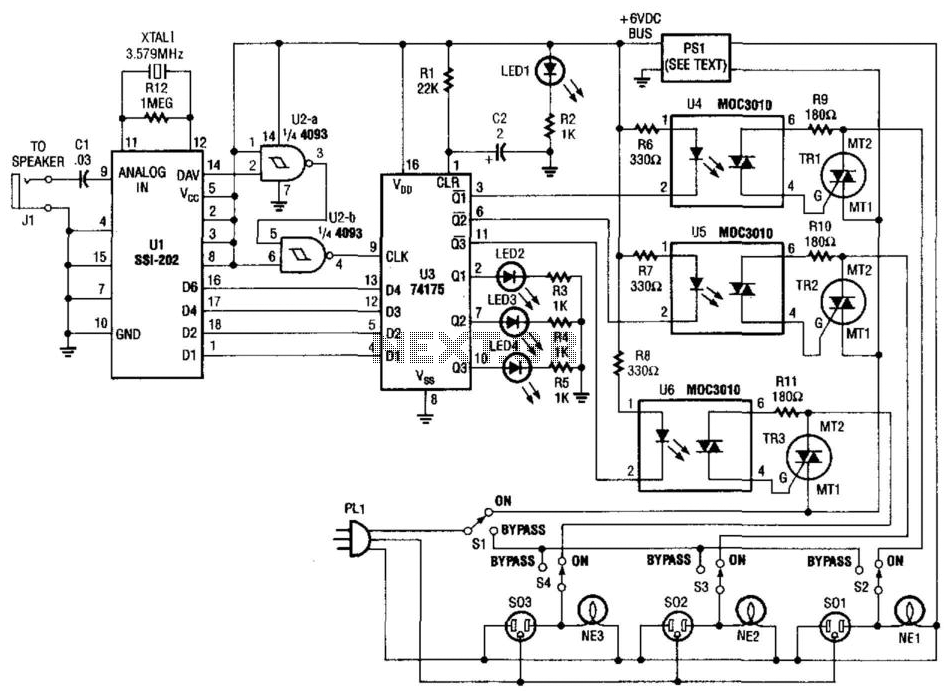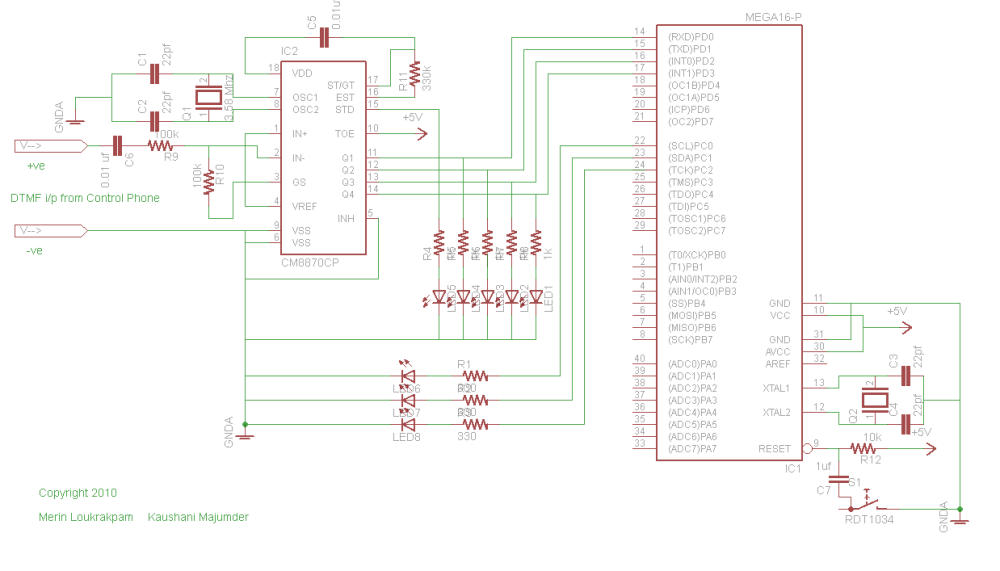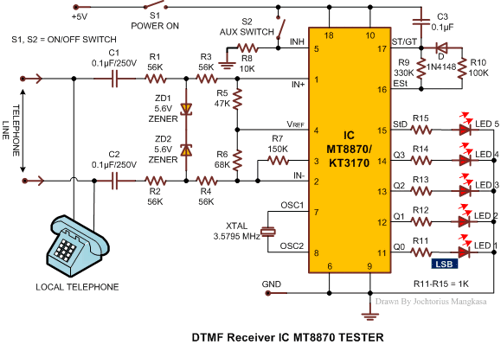
cellphone operated land rover
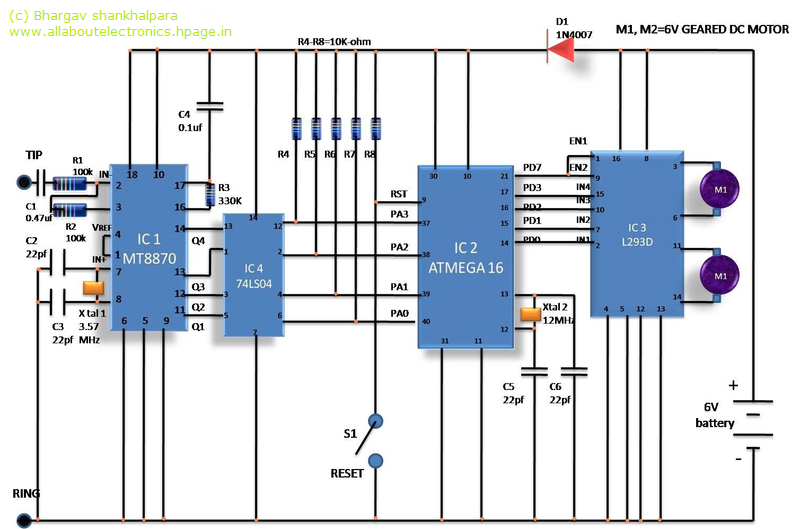
The general principle is that reading prepares an individual, writing fosters daily improvement, and practice leads to perfection. Merely having theoretical knowledge is insufficient for an Electronics and Communication Engineering (ECE) student. A project entails developing hardware alongside software, where theoretical analysis is complemented by design and implementation into integrated circuits (ICs). The final phase involves testing the functionality of the project. This subject provides students with the opportunity for real-world application of theoretical concepts related to robotics and software using the ATmega16 microcontroller in practical scenarios. The project documentation pertains to a mobile-operated land rover, illustrating how hardware and software engineering concepts can be applied to real-world problems. In this project, the robot is controlled via a mobile phone that calls another mobile phone attached to the robot. During the call, pressing any button generates a corresponding tone at the receiving end, known as DTMF (Dual-Tone Multi-Frequency). The robot detects this DTMF tone using the phone mounted on it. The received tone is processed by the ATmega16 microcontroller with the assistance of the DTMF decoder MT8870. The decoder converts the DTMF tone into its binary equivalent, which is sent to the microcontroller. The microcontroller is programmed to make decisions based on the input and directs motor drivers to operate the motors in various directions. The mobile phone calling the robot's phone acts as a remote control, eliminating the need for separate transmitter and receiver units. Key components of this robot include a DTMF decoder, a microcontroller, and a motor driver. The MT8870 series DTMF decoder utilizes digital counting techniques to decode all 16 DTMF tone pairs into a 4-bit code output. Its built-in dial tone rejection circuit negates the need for pre-filtering. When the input signal at pin 2 (IN-) is recognized, the corresponding decode signal is sent to pin 11 through outputs on pins 14. Pins 11 to 14 of the DTMF decoder connect to pins PA0 to PA3 of the microcontroller. The ATmega16 is an 8-bit CMOS microcontroller based on the AVR enhanced RISC architecture, featuring 16KB of in-system programmable flash memory, 512 bytes of EEPROM, 1KB of SRAM, and 32 I/O lines. Outputs from port pins PD0 to PD3 and PD7 of the microcontroller connect to inputs IN1 to IN4 and enable pins (EN1 and EN2) of the L293D motor driver IC to control two geared DC motors. A manual reset switch (S1) is included. Since the microcontroller outputs are insufficient for driving the DC motors, current drivers are necessary for motor operation. The L293D is a quad, high-current, half-H driver capable of providing bidirectional drive currents of up to 600mA at voltages ranging from 4.5V to 36V, facilitating motor control. The L293D consists of four drivers, with pins IN1 to IN4 and OUT1 to OUT4 serving as input and output pins, respectively. Drivers 1 and 2, as well as drivers 3 and 4, are activated by enable pins EN1 (pin 1) and EN2 (pin 9). When EN1 is high, drivers 1 and 2 are enabled, making their outputs active. To operate the robot, a call must be made to the mobile phone attached to the robot from any phone, sending DTMF tones upon pressing numeric buttons. The robot's mobile phone is set to 'auto answer' mode. If the mobile lacks this feature, the call can be received using the 'OK' key and then switched to hands-free mode. After the phone rings, it accepts the call, allowing button presses to perform actions listed in the corresponding table. The generated DTMF tones are received by the robot's cellphone and transmitted to the circuit through the cellphone's headset.
The mobile-operated land rover project exemplifies a practical application of robotics and communication technology, integrating hardware and software seamlessly. The use of the ATmega16 microcontroller provides a robust platform for processing input signals and controlling motor functions through the L293D motor driver. The DTMF decoder MT8870 plays a crucial role in interpreting user commands, converting audio tones into actionable binary signals that the microcontroller can understand. This project not only reinforces theoretical concepts learned in the classroom but also enhances problem-solving skills by addressing real-world challenges through innovative design and implementation. The entire system is designed to be user-friendly, allowing for straightforward operation via standard mobile phones, which broadens accessibility and usability for users unfamiliar with complex robotics systems. The project serves as an excellent educational tool, demonstrating the integration of communication systems, microcontroller programming, and motor control in a cohesive robotic application.I know the general rule of world that reading makes man ready, writing makes man everyday but practice makes man perfect. Only theoretical knowledge is not enough for an E. C (Electronics and communication engineering)student. A project is one of the subjects in which we have to develop hardware with software, where we not theoretically analyze t
he system but also design software and implement the same into the IC. The final phase is to test the functionally of project action. From this subject student can get opportunity of real implementation of theoretically concept of robotics and software in atmega 16 in the practical filed. Here programing, system testing and quality checking and control This documentation the report of mobile operated land rover from this documentation we can understand the hardware and software engineering concept can be implemented to a real problem.
In this project, the robot is controlled by a mobile phone that makes a call to the mobile phone attached to the robot. In the course of a call, if any button is pressed, a tone corresponding to the button pressed is heard at the other end of the call.
This tone is called DTMF (dual-tone-multiple-frequency). The robot perceives this DTMF tone with the help of the phone stacked in the robot. The received tone is processed by the (ATmega16) microcontroller with then help of DTMF decoderMT887o. The decoder decodes the DTMF tone into its equivalent binary digit and this binary number is sent to the microcontroller.
The microcontroller is programmed to take a decision for any given input and outputs its decision to motor drivers in order to drive the motors in forward direction or backward direction or turn. The mobile phone that makes a call to mobile phone stacked in the robot act as a remote. so this robotic project es not require the construction of receiver and transmitter units. The important components of this robot are a DTMF decoder, microcontroller and motor driver. An MT8870 series DTMF decoder is used here. All types of the MT8870 series use digital counting techniques to detect and decode all the 16 DTMF tone pairs into a 4-bit code output.
The built-in dial tone rejection circuit eliminates the need of pre-filtering. when the input signal given at pin 2(IN-) in single-ended input configuration is recognized to be effective, the correct-bit decode signal of the DTMF tone is transferred to (pin11) through (pin14) outputs. The pin11 to pin14 of DTMF decoder are connected to the pins of microcontroller (pa0 to pa3). The ATmega16 is a low power, 8-bit CMOS microcontroller based on the AVR enhanced RISC architecture. it provides the following features: 16kb of in-system programmable flash program memory with read-while-write capabilities, 512 bytes of eeprom, 1kb SRAM, 32(IO) lines.
outputs from port pins PD0 through PD3 and PD7 of the microcontroller are fed to the inputsIN1 through IN4 and enable pins (EN1 and EN2) of motor driver L293D IC, respectively to drive two geared dc motors. Switch S1 is used for manual reset. The microcontroller output is not sufficient to drive the dc motors, so Current drivers are required for motor rotation.
The L293D is a quad, high-current, half-h driver designed to provide bidirectional drive currents of upto600mA at voltages from 4. 5V to 36V. It makes it easier to drive the dc motors. The L293D consists of four drivers. Pins IN1 through IN4 and OUT1 through OUT4 are the input and output pins respectively, of driver 1 through driver 4.
Drivers 1 and 2, and driver 3 and 4 are enabled by enable pin 1(EN1) and pin 9 (EN2), respectively. When enable input EN1 (pin1) is high, drivers 1 and 2 are enabled and the outputs corresponding to their inputs are active. In order to control the robot, you need to make a call to the cell phone attached to the robot (through headphone) from any phone, which sends DTMF tunes on pressing the numeric buttons.
The cell phone in the robotics kept in `auto answer` mode. ( if the mobile does not have the auto answering facility, receive the call by `OK`key on the rover connected mobile and then made it in hands-free mode. ) so after a ring, the cellphone accepts the call. Now you may press any button on your mobile to perform actions as listed in the table. The DTMF tones thus produced are received by the cellphone in the robot. These tones are fed to the circuit by headset of the cellphone. 🔗 External reference
The mobile-operated land rover project exemplifies a practical application of robotics and communication technology, integrating hardware and software seamlessly. The use of the ATmega16 microcontroller provides a robust platform for processing input signals and controlling motor functions through the L293D motor driver. The DTMF decoder MT8870 plays a crucial role in interpreting user commands, converting audio tones into actionable binary signals that the microcontroller can understand. This project not only reinforces theoretical concepts learned in the classroom but also enhances problem-solving skills by addressing real-world challenges through innovative design and implementation. The entire system is designed to be user-friendly, allowing for straightforward operation via standard mobile phones, which broadens accessibility and usability for users unfamiliar with complex robotics systems. The project serves as an excellent educational tool, demonstrating the integration of communication systems, microcontroller programming, and motor control in a cohesive robotic application.I know the general rule of world that reading makes man ready, writing makes man everyday but practice makes man perfect. Only theoretical knowledge is not enough for an E. C (Electronics and communication engineering)student. A project is one of the subjects in which we have to develop hardware with software, where we not theoretically analyze t
he system but also design software and implement the same into the IC. The final phase is to test the functionally of project action. From this subject student can get opportunity of real implementation of theoretically concept of robotics and software in atmega 16 in the practical filed. Here programing, system testing and quality checking and control This documentation the report of mobile operated land rover from this documentation we can understand the hardware and software engineering concept can be implemented to a real problem.
In this project, the robot is controlled by a mobile phone that makes a call to the mobile phone attached to the robot. In the course of a call, if any button is pressed, a tone corresponding to the button pressed is heard at the other end of the call.
This tone is called DTMF (dual-tone-multiple-frequency). The robot perceives this DTMF tone with the help of the phone stacked in the robot. The received tone is processed by the (ATmega16) microcontroller with then help of DTMF decoderMT887o. The decoder decodes the DTMF tone into its equivalent binary digit and this binary number is sent to the microcontroller.
The microcontroller is programmed to take a decision for any given input and outputs its decision to motor drivers in order to drive the motors in forward direction or backward direction or turn. The mobile phone that makes a call to mobile phone stacked in the robot act as a remote. so this robotic project es not require the construction of receiver and transmitter units. The important components of this robot are a DTMF decoder, microcontroller and motor driver. An MT8870 series DTMF decoder is used here. All types of the MT8870 series use digital counting techniques to detect and decode all the 16 DTMF tone pairs into a 4-bit code output.
The built-in dial tone rejection circuit eliminates the need of pre-filtering. when the input signal given at pin 2(IN-) in single-ended input configuration is recognized to be effective, the correct-bit decode signal of the DTMF tone is transferred to (pin11) through (pin14) outputs. The pin11 to pin14 of DTMF decoder are connected to the pins of microcontroller (pa0 to pa3). The ATmega16 is a low power, 8-bit CMOS microcontroller based on the AVR enhanced RISC architecture. it provides the following features: 16kb of in-system programmable flash program memory with read-while-write capabilities, 512 bytes of eeprom, 1kb SRAM, 32(IO) lines.
outputs from port pins PD0 through PD3 and PD7 of the microcontroller are fed to the inputsIN1 through IN4 and enable pins (EN1 and EN2) of motor driver L293D IC, respectively to drive two geared dc motors. Switch S1 is used for manual reset. The microcontroller output is not sufficient to drive the dc motors, so Current drivers are required for motor rotation.
The L293D is a quad, high-current, half-h driver designed to provide bidirectional drive currents of upto600mA at voltages from 4. 5V to 36V. It makes it easier to drive the dc motors. The L293D consists of four drivers. Pins IN1 through IN4 and OUT1 through OUT4 are the input and output pins respectively, of driver 1 through driver 4.
Drivers 1 and 2, and driver 3 and 4 are enabled by enable pin 1(EN1) and pin 9 (EN2), respectively. When enable input EN1 (pin1) is high, drivers 1 and 2 are enabled and the outputs corresponding to their inputs are active. In order to control the robot, you need to make a call to the cell phone attached to the robot (through headphone) from any phone, which sends DTMF tunes on pressing the numeric buttons.
The cell phone in the robotics kept in `auto answer` mode. ( if the mobile does not have the auto answering facility, receive the call by `OK`key on the rover connected mobile and then made it in hands-free mode. ) so after a ring, the cellphone accepts the call. Now you may press any button on your mobile to perform actions as listed in the table. The DTMF tones thus produced are received by the cellphone in the robot. These tones are fed to the circuit by headset of the cellphone. 🔗 External reference
